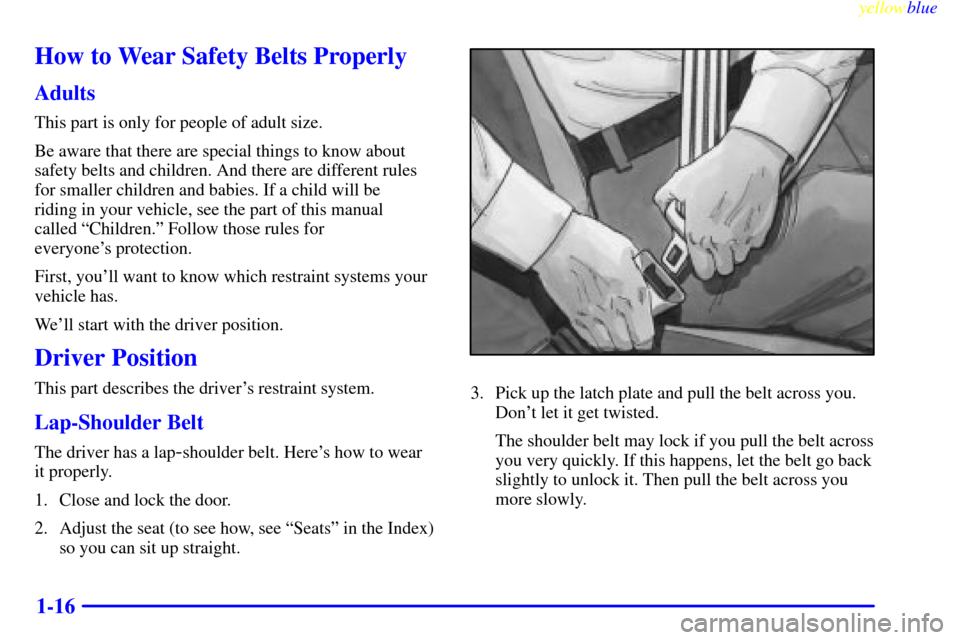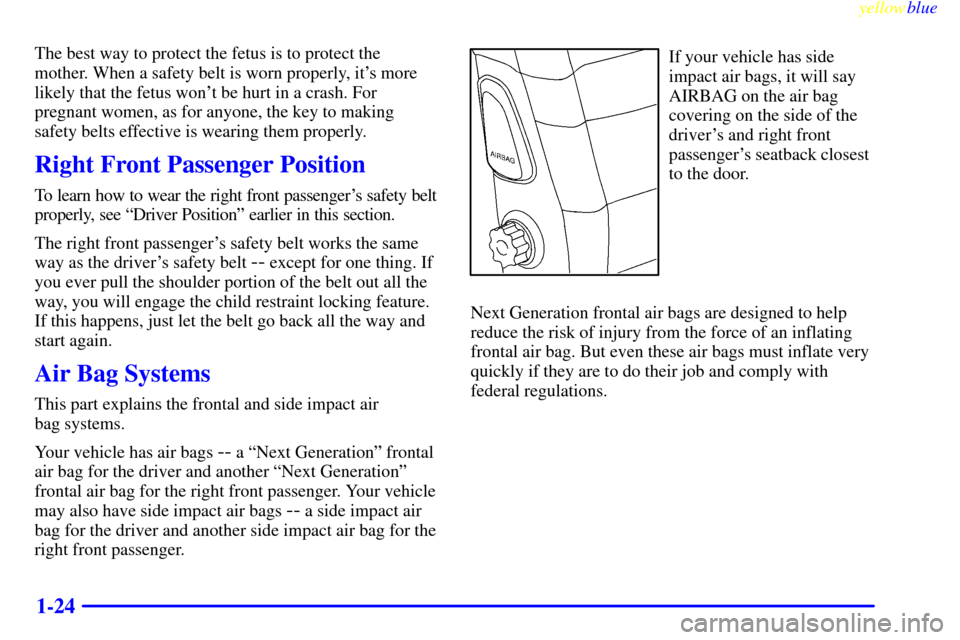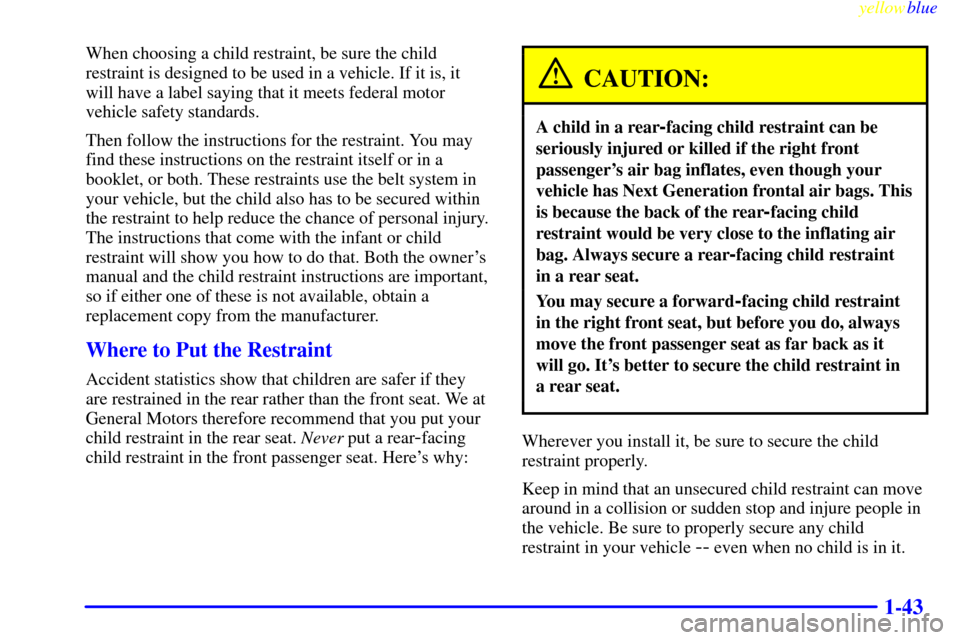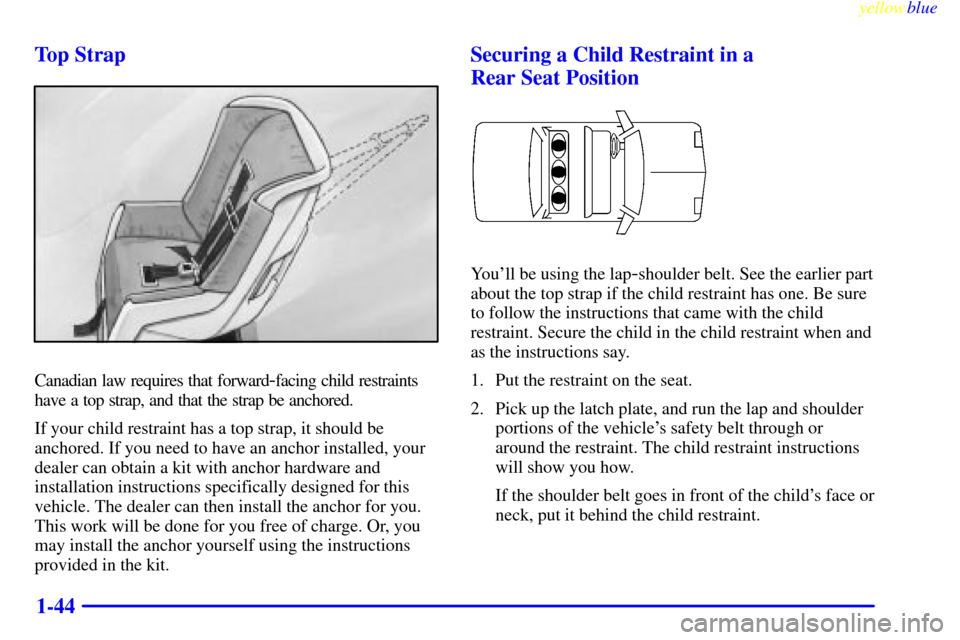Page 9 of 328
1-
yellowblue
1-1
Section 1 Seats and Restraint Systems
Here you'll find information about the seats in your vehicle and how to use your safety belts properly. You can also
learn about some things you should not do with air bags and safety belts.
1
-2 Seats and Seat Controls
1
-10 Safety Belts: They're for Everyone
1
-15 Here are Questions Many People Ask About
Safety Belts
-- and the Answers
1
-16 How to Wear Safety Belts Properly
1
-16 Driver Position
1
-23 Safety Belt Use During Pregnancy
1
-24 Right Front Passenger Position
1
-24 Air Bag Systems1
-32 Safety Belt Pretensioners
1
-32 Rear Seat Passengers
1
-36 Children
1
-39 Child Restraints
1
-49 Larger Children
1
-52 Safety Belt Extender
1
-52 Checking Your Restraint Systems
1
-53 Replacing Restraint System Parts After
a Crash
Page 24 of 328

yellowblue
1-16
How to Wear Safety Belts Properly
Adults
This part is only for people of adult size.
Be aware that there are special things to know about
safety belts and children. And there are different rules
for smaller children and babies. If a child will be
riding in your vehicle, see the part of this manual
called ªChildren.º Follow those rules for
everyone's protection.
First, you'll want to know which restraint systems your
vehicle has.
We'll start with the driver position.
Driver Position
This part describes the driver's restraint system.
Lap-Shoulder Belt
The driver has a lap-shoulder belt. Here's how to wear
it properly.
1. Close and lock the door.
2. Adjust the seat (to see how, see ªSeatsº in the Index)
so you can sit up straight.
3. Pick up the latch plate and pull the belt across you.
Don't let it get twisted.
The shoulder belt may lock if you pull the belt across
you very quickly. If this happens, let the belt go back
slightly to unlock it. Then pull the belt across you
more slowly.
Page 32 of 328

yellowblue
1-24
The best way to protect the fetus is to protect the
mother. When a safety belt is worn properly, it's more
likely that the fetus won't be hurt in a crash. For
pregnant women, as for anyone, the key to making
safety belts effective is wearing them properly.
Right Front Passenger Position
To learn how to wear the right front passenger's safety belt
properly, see ªDriver Positionº earlier in this section.
The right front passenger's safety belt works the same
way as the driver's safety belt
-- except for one thing. If
you ever pull the shoulder portion of the belt out all the
way, you will engage the child restraint locking feature.
If this happens, just let the belt go back all the way and
start again.
Air Bag Systems
This part explains the frontal and side impact air
bag systems.
Your vehicle has air bags
-- a ªNext Generationº frontal
air bag for the driver and another ªNext Generationº
frontal air bag for the right front passenger. Your vehicle
may also have side impact air bags
-- a side impact air
bag for the driver and another side impact air bag for the
right front passenger.
If your vehicle has side
impact air bags, it will say
AIRBAG on the air bag
covering on the side of the
driver's and right front
passenger's seatback closest
to the door.
Next Generation frontal air bags are designed to help
reduce the risk of injury from the force of an inflating
frontal air bag. But even these air bags must inflate very
quickly if they are to do their job and comply with
federal regulations.
Page 49 of 328
yellowblue
1-41
A forward-facing child restraint (C-E) positions a
child upright to face forward in the vehicle. These
forward
-facing restraints are designed to help protect
children who are from 20 to 40 lbs. (9 to 18 kg) and
about 26 to 40 inches (66 to 102 cm) in height, or up
to around four years of age. One type, a convertible
restraint, is designed to be used either as a rear
-facing
infant seat or a forward
-facing child seat.
Page 50 of 328
yellowblue
1-42
A booster seat (F, G) is designed for children
who are about 40 to 60 lbs., or even up to 80 lbs.
(18 to 27 kg, or even up to 36 kg), and about four
to eight years of age. A booster seat is designed to
improve the fit of the vehicle's safety belt system.
Booster seats with shields use lap
-only belts;
however, booster seats without shields use
lap
-shoulder belts. Booster seats can also help a
child to see out the window.
Page 51 of 328

yellowblue
1-43
When choosing a child restraint, be sure the child
restraint is designed to be used in a vehicle. If it is, it
will have a label saying that it meets federal motor
vehicle safety standards.
Then follow the instructions for the restraint. You may
find these instructions on the restraint itself or in a
booklet, or both. These restraints use the belt system in
your vehicle, but the child also has to be secured within
the restraint to help reduce the chance of personal injury.
The instructions that come with the infant or child
restraint will show you how to do that. Both the owner's
manual and the child restraint instructions are important,
so if either one of these is not available, obtain a
replacement copy from the manufacturer.
Where to Put the Restraint
Accident statistics show that children are safer if they
are restrained in the rear rather than the front seat. We at
General Motors therefore recommend that you put your
child restraint in the rear seat. Never put a rear
-facing
child restraint in the front passenger seat. Here's why:
CAUTION:
A child in a rear-facing child restraint can be
seriously injured or killed if the right front
passenger's air bag inflates, even though your
vehicle has Next Generation frontal air bags. This
is because the back of the rear
-facing child
restraint would be very close to the inflating air
bag. Always secure a rear
-facing child restraint
in a rear seat.
You may secure a forward-facing child restraint
in the right front seat, but before you do, always
move the front passenger seat as far back as it
will go. It's better to secure the child restraint in
a rear seat.
Wherever you install it, be sure to secure the child
restraint properly.
Keep in mind that an unsecured child restraint can move
around in a collision or sudden stop and injure people in
the vehicle. Be sure to properly secure any child
restraint in your vehicle
-- even when no child is in it.
Page 52 of 328

yellowblue
1-44 Top Strap
Canadian law requires that forward-facing child restraints
have a top strap, and that the strap be anchored.
If your child restraint has a top strap, it should be
anchored. If you need to have an anchor installed, your
dealer can obtain a kit with anchor hardware and
installation instructions specifically designed for this
vehicle. The dealer can then install the anchor for you.
This work will be done for you free of charge. Or, you
may install the anchor yourself using the instructions
provided in the kit.
Securing a Child Restraint in a
Rear Seat Position
You'll be using the lap-shoulder belt. See the earlier part
about the top strap if the child restraint has one. Be sure
to follow the instructions that came with the child
restraint. Secure the child in the child restraint when and
as the instructions say.
1. Put the restraint on the seat.
2. Pick up the latch plate, and run the lap and shoulder
portions of the vehicle's safety belt through or
around the restraint. The child restraint instructions
will show you how.
If the shoulder belt goes in front of the child's face or
neck, put it behind the child restraint.
Page 54 of 328
yellowblue
1-46
5. To tighten the belt, feed the shoulder belt back into
the retractor while you push down on the child
restraint. If you're using a forward
-facing child
restraint, you may find it helpful to use your knee to
push down on the child restraint as you tighten
the belt.6. Push and pull the child restraint in different
directions to be sure it is secure.
To remove the child restraint, just unbuckle the vehicle's
safety belt and let it go back all the way. The safety belt
will move freely again and be ready to work for an adult
or larger child passenger.
Securing a Child Restraint in the Right
Front Seat Position
Your vehicle has a right front passenger air bag. Never
put a rear
-facing child restraint in this seat. Here's why: